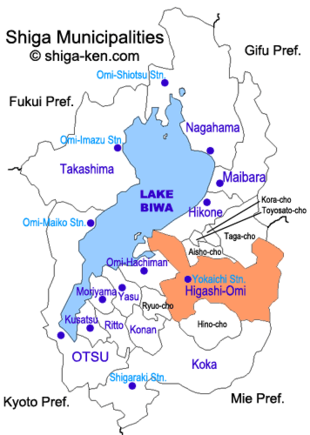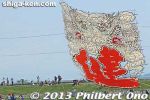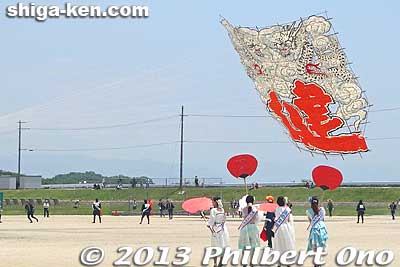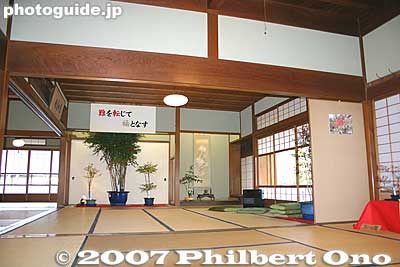Higashi-Omi, Shiga: Difference between revisions
(Created page with "<div style="float:right;width:330px;"> {{City | Name = HigashiOmi | JapaneseName = 東近江市 | RomanName = HigashiOmi-shi | Prefecture = Shiga | Region = Kinki |...") |
No edit summary |
||
| Line 292: | Line 292: | ||
{{Japan}} | {{Japan}} | ||
[[Category:HigashiOmi, Shiga]] | [[Category:HigashiOmi, Shiga]] | ||
[[Category:Shiga Prefecture]] | [[Category:Shiga Prefecture]] | ||
Revision as of 16:39, 18 April 2019
| HigashiOmi, Shiga (東近江市; HigashiOmi-shi) | ||
 Iba-no-saka-kudashi Matsuri. More HigashiOmi photos here. Iba-no-saka-kudashi Matsuri. More HigashiOmi photos here.
| ||

| ||
| Location | Shiga Prefecture, Kinki region, Honshu island, JAPAN | |
| Population | 113,944 (1,890 foreigners) (2014-06-01) | |
| Area | 383.36 km² | |
| City Centers | Yokaichi, Gokasho, Notogawa, Eigenji | |
| Major Sights | Yokaichi Giant Kite Festival, Gokasho Omi shonin merchant homes, Notogawa Giant Waterwheel, Eigenji Temple, Hyakusaiji Temple | |
| Major Gateways | Ohmi Railways Yokaichi Station, JR Notogawa Station, JR Omi-Hachiman Station (Omi-Hachiman) | |
| Train Stations | JR Tokaido Line Notogawa Station; Ohmi Railways Gokasho Station, Kawabe no Mori Station, Yokaichi Station, Nagatanino Station, Daigaku-mae Station, Kyocera-mae Station, Sakuragawa Station, Asahi Otsuka Station, Asahino Station, Shin-Yokaichi, Tarobogu-mae Station, Ichinobe Station, Hirata Station | |
| Claim to Fame | Yokaichi Giant Kite Festival in late May, Eigenji Temple fall colors | |
| Products | ||
| Neighbors | Omi-Hachiman, Hino-cho, Ryuo-cho, Aisho-cho, Taga-cho, Koka, Mie Pref. | |
| Old Name(s) | Yokaichi, Gokasho-cho, Eigenji-cho, Notogawa-cho, Aito-cho, Gamo-cho, Koto-cho | |
| Keywords | Yokaichi, odako giant kite, Omi shonin, suisha waterwheel | |
| Historical Persons | ||
| Links | HigashiOmi Articles | HigashiOmi Photos | |
| HigashiOmi Tourist Information | ||
| Location | 八日市まちかど情報館
滋賀県東近江市八日市本町14-25
| |
| Phone | (0748) 23-4528
City Hall Tourism: (0748) 24-5662 | |
| Tourist Links | City Tourism | |
| Int'l Association | Web site Tel: 0748-24-5610 | |
| Volunteer Guides | Tel: Yokaichi 0748-24-5662,
Eigenji 0748-27-1121, Gokasho 0748-48-2100, Aito 0749-46-2264, Gamo 0748-55-4882 | |
| HigashiOmi City Hall 東近江市役所 | ||
| Address | 527-8527滋賀県東近江市八日市緑町10番5号
Midori-machi 10-5, Yokaichi, Higashiomi-shi, Shiga JAPAN | |
| Phone/Fax | (0748) 24-1234 Fax: (0748) 24-0752 | |
| Official Site | Japanese | | |
| Symbols | Flower: | -- |
| Tree: | -- | |
| Bird: | -- | |
| Others: | Giant kite | |
| Logo: | 
| |
| Sister Cities | Marquette, Michigan, USA; Taber, Alberta, Canada; Rättvik, Dalarna County, Sweden; Jang-am-myeon and Tongyeong in South Korea; Changde, Hunan, China | |
by Philbert Ono
Giant kites and much more
Higashi-Omi (東近江市; also spelled Higashiomi) is a city in Shiga Prefecture east of Lake Biwa.
Centering on the former city of Yokaichi 八日市, where Yokaichi Station and the city hall are located, Higashi-Omi is spread over a wide area from Notogawa on the shore of Lake Biwa to the mountains in Eigenji bordering with Mie Prefecture. It is most famous for its giant kite festival held on the last Sunday of May (cancelled in 2016). In fall, Eigenji temple is a popular place for autumn foilage. The city is largely rural, with the population and businesses concentrated in Yokaichi and Notogawa. There are also a few large factories, especially electronics.
Higashi-Omi was newly formed in 2005 through municipal mergers with neighboring towns Eigenji-cho, Gokasho-cho, Aito-cho, Koto-cho, and later Notogawa-cho and Gamo-cho in 2006. The later joining of Notogawa-cho finally gave the formerly landlocked city a lake shore as well as a train station (Notogawa) on the busy JR Tokaido/Biwako Line. The city's land area is now the third largest in Shiga.
It has numerous train stations along the Ohmi Railway Line. The city's name is pronounced "Higashi-Omi," not "Higashio-mi" nor "Higa-shiomi." The break is between "Higashi" and "Omi."
Sights

| 
| 
|
| Yokaichi Kite Festival | Making giant kite | Gokasho Omi Merchant Home |

| 
| 
|
| Eigenji Temple | Hyakusaiji Temple | Notogawa |
- Higashi-Omi Giant Kite Festival 東近江大凧まつり - (Note: Due to a tragic kite crash in May 2015, this kite festival has been suspended since May 2016. It will not be held in May 2019.) Formerly the Yokaichi Giant Kite Festival, the symbol of Higashiomi (especially Yokaichi), this giant kite festival is the city's biggest event, one of Shiga's major festivals, and one of Japan's major giant kite festivals. It is held annually on the last Sunday of May along the Echigawa Riverbank at Fureai Undo Park in Notogawa. (Note that the festival site has moved to Fureai Undo Park from 2013.) The giant kite is made of paper and a bamboo frame. A new one is made every three years (photos here), with a new design each time. The kite design, called hanjimon (判じもん), always has a twin pair of creatures and a large kanji character. Together they form a thematic catch phrase based on word play. After a design theme like "Life" or "Health" is decided, kite designs are solicited from the public every three years for the new giant kite. The winning designer receives 20,000 yen. On festival day, the public can sign up to pull the giant kite as well. With enough wind, the giant kite can stay aloft for a long time. From Yokaichi Station, there are shuttle buses going to the festival site. Map
- Higashi-Omi Giant Kite Museum 東近江大凧会館 - Formerly the Yokaichi Giant Kite Museum, the Higashi-Omi Giant Kite Museum exhibits the giant kite used previously for the Giant Kite Festival, as well as many different kites from all over Japan and the world. Very impressive. Walk or take a bus from Ohmi Railways Yokaichi Station. Map
- Gokasho 五個荘 - Traditional and grand homes of successful Omi shonin merchants. Four of them are open to the public, and the Omi Merchant Museum is also of interest. The Omi merchants' backbone philosophy strived to benefit all three parties concerned: The seller, customer, and society at large. Near Ohmi Railways Gokasho Station or take a bus from JR Notogawa Station. Road signs and free maps make it easy to find the homes and museum. Map
- Eigenji 永源寺 - Established in 1361 by Zen Rinzai Sect priest and poet Jakushitsu Genko (寂室 元光 1290-1367) , Eigenji is a temple of the Zen Rinzai Buddhist Sect (Eigenji School) and well-known for fall colors with 3,000 maple trees. Although not part of the Koto Sanzan Temple Trio (all Tendai Buddhist temples), most visitors also visit Eigenji together with the Koto Sanzan temples. Accessible by bus taking 30-40 min. from Yokaichi Station on the Ohmi Railways or from Hyakusaiji. Admission 500 yen. Map
- Hyakusaiji 百済寺 - Established by Shotoku Taishi in 609, this is Shiga Prefecture's oldest temple and one of Japan's oldest. It belongs to the Tendai Buddhist Sect. Being the southern-most temple in the Koto Sanzan Temple Trio, visit it after Eigenji or Kongorinji Temple. The hillside garden is noted for spring flowers and autumn foilage and also gives a good view of Lake Biwa. The main temple hall worships an 11-faced Kannon statue carved by Shotoku Taishi. Admission 600 yen. In spring and fall, buses run from Yokaichi Station. Or 15 min. by taxi. Map
- Notogawa Waterwheel - Giant waterwheel made of wood in a large, lakeside park near Lake Biwa. A small waterwheel museum also shows how a waterwheel is used to grind grain or pound mochi. Great place for bicycling. Also canoeing. Map
- Tarobogu Shrine 太郎坊 - Shrine on a small mountain near Tarobogu-mae Station. Grand views of the surrounding area and a pair of Wedded Rocks. Map
Event Calendar
- 2nd Mon. in Jan. - Coming of Age Ceremony with Giant Kite.
- May 4 - Iba-no-saka-kudashi Matsuri Festival 伊庭の坂下し祭 Held on May 4 by Sanposan Shrine in Higashi-Omi, Shiga Prefecture, three portable shrines are hauled down a steep mountain (Kinugasa-yama) for about 500 meters. Map
- 4th Sun. in May - Higashi-Omi Giant Kite Festival - Formerly named "Yokaichi Giant Kite Festival" highlighted by a giant kite. '(Note: This kite festival has been suspended since May 2016 due to a tragic kite crash in May 2015. It will not be held in May 2019.) Map
- Late July - Shotoku Matsuri, Higashi-Omi. Folk dance festival in front of Yokaichi Station on the Omi Railways. Hundreds of people will dance the Goshu Ondo (江州音頭) which is a bon dance and folk song native to Shiga. First there is a parade of mascot characters from 7 pm to 7:40 pm, followed by the folk dancers from 7:50 pm to 8:40 pm on the road perpendicular to Yokaichi Station. http://www.odakocci.jp/pickup/matsuri.html Map
- Nov. - Fall colors at Eigenji Temple and Hyakusaiji Temple
- 1st Sun. in Dec. - Tarobogu Shrine Bonfire Festival - The bonfire is used to burn about 100,000 goma prayer tablets collected from all over Japan. The fire's spiritual force supposed to ward off accidents and sickness. Toward the end, there is fire-walking on the hot embers.
Travel Tips
- To go to Yokaichi Station from the Tokaido Main Line, transfer trains at Omi-Hachiman Station and board the Ohmi Railways. From Maibara or Hikone Station, it is possible to take the Ohmi Railways, but it might be faster to take the Tokaido Main Line to Omi-Hachiman and transfer to Ohmi Railways there.
- Near Yokaichi Station, inside the Honmachi shopping arcade, the Machikado Joho-kan (Information Hall) is a tourist info office and souvenir shop.
- If you see the Higashiomi Giant Kite Festival, you can apply on-site to pull the giant kite. You will have to run for 50 meters or so, so don't carry a rucksack or camera when pulling the kite.
- Starting your Gokasho tour from Notogawa Station by bus (get off at Iki-iki-kan-mae bus stop) might be better than starting from Gokasho Station. The Iki-iki-kan center has a tourist info office, whereas Gokasho has no tourist info office.
- To see Eigenji in Nov., take a bus from Yokaichi Station. Buy a discount bus pass which you can use visit Eigenji and the Koto Sanzan Temple Trio.
Getting There
By Train
Higashi-Omi has two main train stations: Yokaichi Station on the Ohmi Railways Main Line, and Notogawa Station on the Tokaido/Biwako Line. Yokaichi Station is at the city center, near City Hall, while Notogawa Station is on the fringe toward Lake Biwa, near the giant waterwheel park. Both of these stations have local buses which run within the city. There is also Gokasho Station which is near the Omi-shonin merchant homes.
Yokaichi Station is accessible from Maibara Station (if you are coming from Tokyo), Omi-Hachiman Station (if you are coming from Kyoto/Osaka), and Kibukawa Station (if you are coming from the Kusatsu Line). Notogawa Station is accessible from Maibara Station and any station on the Tokaido Main Line (Osaka/Kyoto).
Train Lines & Stations
- JR Tokaido/Biwako Line: Notogawa Station
- Ohmi Railways Main Line (Honsen): Yokaichi Station, Gokasho Station, and others (See Getting Around below.)
Travel Time
- From Tokyo Station to Yokaichi Station: JR Tokaido Shinkansen to Maibara Station (2.5 hours), then transfer to Ohmi Railways for Yokaichi Station (45 min.).
- From Tokyo Station to Notogawa Station: JR Tokaido Shinkansen to Maibara Station (2.5 hours), then transfer to Tokaido Main Line for Notogawa Station (18 min.).
- From Kyoto Station to Yokaichi Station: JR Tokaido/Biwako Line bound for Maibara or Nagahama and get off at Omi-Hachiman Station (33 min.), then transfer to Ohmi Railways (18 min.).
- From Kyoto Station to Notogawa Station: JR Tokaido Main Line shin-kaisoku bound for Maibara or Nagahama (39 min.)
- From Maibara Station to Yokaichi Station: 45 min. via Ohmi Railways
- From Omi-Hachiman Station to Yokaichi Station: 18 min. via Ohmi Railways
- From Kibukawa Station to Yokaichi Station: 43 min. via Ohmi Railways
Nearest Airports
- Kansai International Airport
- Central Japan International Airport (Centrair)
- Osaka International Airport
Getting Around
The city has numerous train stations, especially on the Ohmi Railways. The main train stations are Notogawa Station on the Tokaido Main Line and Yokaichi Station on the Ohmi Railways. Local buses also stop at these two stations.
By train
Besides Notogawa Station on the coveted JR Tokaido Main Line near the shore of Lake Biwa, Higashi-Omi's main form of public transportation is Ohmi Railways and local buses running from Yokaichi Station to places like Eigenji in the interior. The major sights and destinations along the train lines within the city are as follows:
- Notogawa Station (能登川駅) - Giant water wheel is the town's symbol, and the station's facade is also partially shaped like a water wheel. A small shopping center is next to the station.
Main Line (Honsen) (本線)
- Gokasho Station (五箇荘駅) - Famous for Omi merchant homes.
- Kawabe-no-Mori Station (河辺の森駅) - Near Kawabe Ikimono no Mori nature park.
- Yokaichi Station (八日市駅) - Main station for HigashiOmi city and transfer point for the Ohmi Railways' Main Line and Yokaichi Line (for Omi-Hachiman).
- Nagatanino Station (長谷野駅) -
- Daigaku-mae Station (大学前駅) -
- Kyocera-mae Station (京セラ前駅) - Near Kyocera factories.
- Sakuragawa Station (桜川駅) -
- Asahi Otsuka Station (朝日大塚駅) -
- Asahino Station (朝日野駅) -
Yokaichi Line (八日市線)
Runs betweenOmi-Hachiman Station on the Tokaido Line and Yokaichi Station in Higashi Omi.
- Hirata Station (平田) -
- Ichinobe Station (市辺) -
- Tarobogu-mae Station (太郎坊宮前) - Unmanned train station. Mainly residential and farmland. Tarobogu Shrine is nearby on a scenic, rocky mountain.
- Shin-Yokaichi Station (新八日市) - Nice Taisho-Period station building.
- Yokaichi Station (八日市) - Main station at the center of Higashi Omi city (formerly Yokaichi city).
By bus
Since Yokaichi Station is the city's main station, local bus service starts here. The bus route goes as far as Eigenji. Taxis also are available at Yokaichi Station. Buses from Notogawa Station also go to Gokasho and Yokaichi.
Maps
Click on upper right icon to view a larger map.
Photos

| 
|
| Odako Matsuri | Gokasho |
More photos at Higashi-Omi Photos.
Videos
Higashi-Omi Giant Kite Festival 2013 video with three English-speaking kids:
Higashi-Omi Giant Kite Museum 2013 video with three English-speaking kids:
Yokaichi Shotoku Matsuri in late July:
More Shiga videos here.
History
- 1932 - Notogawa-cho town established through the merging of several villages.
- 1954 - City of Yokaichi established through the merging of Yokaichi town with several neighboring villages. Koto-cho town established through the merging of neighboring villages.
- 1955 - Towns of Eigenji-cho, Gokasho-cho, and Gamo-cho and Aito Village established through the merging of several villages.
- 1971 - Aito Village becomes Aito-cho town.
- 1982 - The Yokaichi Odako Matsuri giant kite festival starts to be held annually.
- 2005
- February 11: Yokaichi city and the towns of Eigenji-cho, Gokasho-cho, Aito-cho, and Koto-cho merged to form HigashiOmi city. Yokaichi and the four towns were thereby dissolved.
- 2006
- Jan. 1 - The adjacent lakeside town of Notogawa-cho and Gamo-cho merge with HigashiOmi
- Dec. 1 - Cable TV service commences by the HigashiOmi Cable TV.
- 2012 - The Yokaichi Odako Matsuri (Giant Kite Festival) changes its name to HigashiOmi Odako Matsuri.
- 2013 - The HigashiOmi Odako Matsuri (Giant Kite Festival) is held at the new site of Fureai Undo Koen Park in Notogawa for the first time.
- 2015 - The giant kite flown at the HigashiOmi Odako Matsuri (Giant Kite Festival) crashes on spectators, killing one person and injuring several others.
- 2016 - The HigashiOmi Odako Matsuri (Giant Kite Festival) is cancelled for the first time due to the fatal kite crash in May 2015.
Additional Reading
Higashi-Omi has agreed to pay ¥32 million in compensation to the family of the age 73 man from Sakai, Osaka who died when the giant kite fell on him at the Odako Matsuri giant kite festival in May 2015. Still unknown when the kite festival will restart. Won't be in 2018.
— Shiga Headlines (@ShigaHeadlines) February 28, 2018
- Notogawa Station one of Top 20 train stations in Shiga Prefecture - May 20, 2014
- Origin of Yokaichi Shotoku Matsuri Goshu Ondo - August 30, 2013
- Higashi-Omi Giant Kite Festival 2013
- Yokaichi giant kite under construction - July 18, 2010
- Making Yokaichi giant kite - July 9, 2007
- Japan’s oldest clay figure in Higashi-Omi - June 19, 2010
- Yokaichi Giant Kite crashes into bamboo - June 3, 2007
- How to spell 東近江? - September 18, 2006
Miscellaneous
Trivia
- The city is Shiga's third largest city in area.
- There was once an air field in the city.
Famous People
- Takemura Masayoshi 武村 正義 (1934-) - Native of Yokaichi (Higashi-Omi) who served as mayor of Yokaichi in 1971, and elected governor of Shiga in 1974 serving three terms until 1986 during which he instituted a number of well-received environmental measures for Lake Biwa. That same year, he is elected to the National Diet. In 1993 in the cabinet of Hosokawa Morihiro, he becomes Chief Cabinet Secretary. During 1994-1996, in the Cabinet of Murayama Tomiichi, he serves as Minister of Finance when the consumption tax was raised from 3% to 5%.
Side Trips
Other sights in neighboring cities/towns within easy reach from Higashi-Omi.
- Omi-Hachiman - Connected by Ohmi Railways Yokaichi Line in only 17 min.
- Minakuchi - In Koka, easily accesible via Ohmi Railways.
- Hino-cho - Easily accesible via Ohmi Railways.
- Hikone - Easily accessible via Ohmi Railways.
Related Articles
- Shiga Prefecture
- Shiga Prefecture Sights
- Shiga Prefecture Transportation
- Shiga Prefecture Municipalities
External Links
| Municipalities of Shiga Prefecture 滋賀県 | ||
| Cities & Towns: Aisho-cho | Higashi-Omi | Hikone | Hino-cho | Koka | Konan | Kora-cho | Kusatsu | Maibara | Moriyama | Nagahama | Omi-Hachiman | Otsu | Ritto | Ryuo-cho | Taga-cho | Takashima | Toyosato-cho | Yasu | ||
| 愛荘町 | 東近江市 | 彦根市 | 日野町 | 甲賀市 | 湖南市 | 甲良町 | 草津市 | 米原市 | 守山市 | 長浜市 | 近江八幡市 | 大津市 | 栗東市 | 竜王町 | 多賀町 | 高島市 | 豊郷町 | 野洲市 | ||
| Prefectures of Japan | ||
| Aichi | Akita | Aomori | Chiba | Ehime | Fukui | Fukuoka | Fukushima | Gifu | Gunma | Hiroshima | Hokkaido | Hyogo | Ibaraki | Ishikawa | Iwate | Kagawa | Kagoshima | Kanagawa | Kochi | Kumamoto | Kyoto | Mie | Miyagi | Miyazaki | Nagano | Nagasaki | Nara | Niigata | Oita | Okayama | Okinawa | Osaka | Saga | Saitama | Shiga | Shimane | Shizuoka | Tochigi | Tokushima | Tokyo | Tottori | Toyama | Wakayama | Yamagata | Yamaguchi | Yamanashi | ||